How to Invest in S&P 500: Own a Piece of the U.S. Economy

Every time you check your phone, stream your favorite series, or sip a cold drink, you could be profiting from the companies behind those moments. The S&P 500 makes that possible. It’s not just an index; it’s your chance to invest in the heartbeat of the U.S. economy through the success of 500 top companies like Apple, Netflix, Coca-Cola, and more.
We’re not here to oversell. But let’s point this out: if an asset with an average annual price return of 11.7% over the last 10 years piques your interest, this is something worth exploring. In fact, €1,000 invested in the S&P 500 in 2010 would now be nearly €4,707—and that’s even without dividends.
Curious about how it works and why it’s so popular? Whether you’re a complete beginner or just realizing that indexes are pretty straightforward investment type you simply can’t overlook, this guide will walk you through everything you need to know to invest in the S&P 500—no barriers, no commissions, from anywhere.
What Is the S&P 500?
The S&P 500, short for the Standard & Poor's 500 Index, is a financial index that tracks the performance of 500 of the largest publicly traded companies in the United States. If the U.S. economy had a “who’s who” list of businesses, the S&P 500 would be it.
The S&P 500 was launched in 1957, designed to provide a comprehensive overview of the stock market. You may think a double meaning here, but its name comes from Standard Statistics and Poor’s Publishing, two firms that merged to create the financial giant we now know as S&P Global.
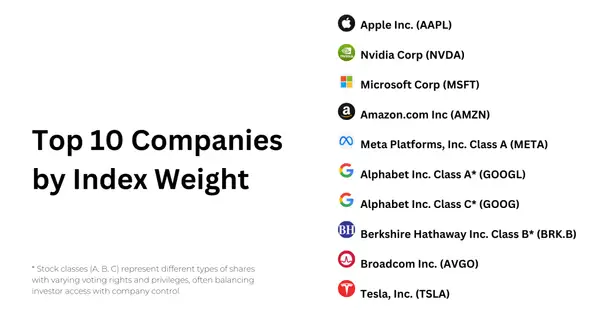
How is S&P 500 Calculated
The S&P 500 is calculated using a market capitalization-weighted system. This means each company’s influence on the index depends on its size, measured by its market capitalization.
For example, larger companies like Apple and Microsoft have a bigger impact on the S&P 500’s overall performance compared to smaller companies in the index.
Why It Stands Out
Unlike smaller indexes, the S&P 500 is considered the gold standard for investing because it represents a diverse range of industries, from technology and healthcare to finance and consumer goods. This diversity reduces risk, as the index isn't overly reliant on a single sector.
S&P 500 Performance
The S&P 500’s performance over time showcases its strength as a long-term investment. Here’s a snapshot of its average annual returns:

Source: S&P Global.
The 31.08% return over the last year reflects a remarkable recovery, fueled by a combination of strong corporate earnings and improving market conditions. Notably, the S&P 500 hit a new peak earlier this month following the U.S. elections, as investor confidence surged with the resolution of political uncertainty.

What’s Next for the S&P 500?
According to recent market forecast, the index is projected to grow by another 9% in the next 12 months, driven by expected corporate earnings growth of 11% in 2025 and 7% the year after.
Want to track the S&P 500’s performance in real time? Create your watchlist on Morpher for S&P 500 tracker and stay updated with every market move.
How to Invest in the S&P 500 Index from Europe
Investing in the S&P 500 is easier than ever with Morpher. With access to 700 U.S. stocks and major indices, including the S&P 500, you can trade from anywhere in Europe, completely commission-free. Follow these simple steps to get started:
Step 1: Download the Morpher mobile app.
Start by downloading the Morpher mobile app from your app store. It’s designed for seamless trading on the go, so you can manage your investments anytime, anywhere.
Step 2: Sign Up on Morpher
Morpher’s platform is designed to be accessible for every level of traders. Plus, you can start trading without completing KYC verification until your account balance exceeds the limit. Create your account in less than 5 minutes.
Step 3: Deposit Funds
Morpher makes it easy to start investing by allowing you to directly deposit euros into your account. Thanks to fractional trading, you don’t need a large budget—you can begin with any amount that works for you. Even a small deposit lets you own a piece of the S&P 500, giving you the flexibility to grow your portfolio at your own pace.
Step 4: Select S&P 500 Index
Navigate to the Indices menu and choose the S&P 500 (SP500) Index. Review key details shown in the example below, such as market capitalization, price, and the weight of its top components.
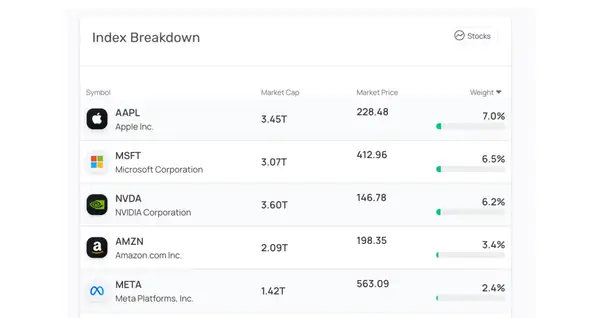
Step 4: Set Up Your Position
Enter Your Investment Amount: Specify how much you’d like to invest in the S&P 500.
Adjust Leverage (Optional): Customize your leverage settings if desired. 10x leverage is available on Morpher with negative account protection.
Place the Trade: Click Buy to confirm and execute your order.
Step 5: Enjoy Zero-Commission Trading
Unlike traditional brokers, Morpher charges no commissions, transaction fees, or hidden costs. You can open short or long positions and keep 100% of your profits. Want to know about how this works? Check out Morpher’s zero-commission trading system to see how we’re helping traders grow their portfolios.
Step 7: Morpher AI for Real-Time Market Insights
Stay ahead with S&P 500 index real-time market insights powered by Morpher’s AI, helping you make informed investment decisions.
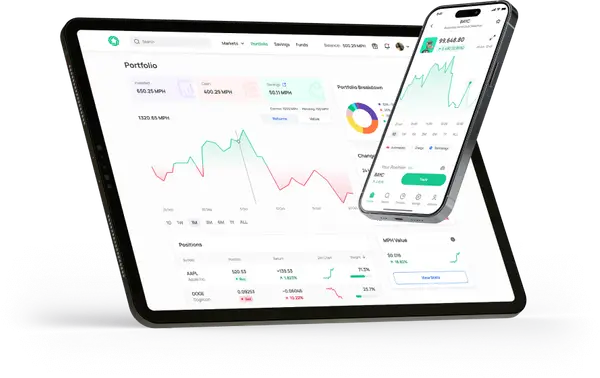
Plus, Morpher’s platform is built on blockchain technology, ensuring every transaction is secure, transparent, and tamper-proof. It’s a modern, reliable way to invest with confidence.
Ready to start? Sign up on Morpher today and take your first step toward investing in the S&P 500 from anywhere in Europe—hassle-free, commission-free.
Why ETFs and Funds Fall Short
S&P 500 ETFs are incredibly popular worldwide, offering an easy way to invest in the index. However, they come with several drawbacks that investors often overlook:
At the end of the day, what truly matters is how much you keep, not how much your broker earns.
- Hidden Fees:
ETFs and mutual funds come with various fees, management fees (expense ratios), transaction fees, withdrawal fees, and sometimes it feels like fees just for existing (kidding, but close). While these fees may seem minor, they can add up significantly over time, eating into your overall returns. - Dividend Payout Delays:
ETFs typically pool dividends from the underlying stocks and distribute them quarterly, meaning you don’t get immediate access to your returns. On Morpher, you can close your position and withdraw your profits instantly, whenever you want. - Tax Inefficiency:
Depending on your country of residence, you may face additional taxes when dividends are paid out by ETFs, even if you reinvest them.
Compare S&P 500 with Other Indexes
Dow Jones vs. S&P 500
The Dow Jones Industrial Average index represents just 30 large companies, primarily industrial giants. While it offers historical significance and insight into the performance of blue-chip stocks, it lacks the sector diversity of the S&P 500.
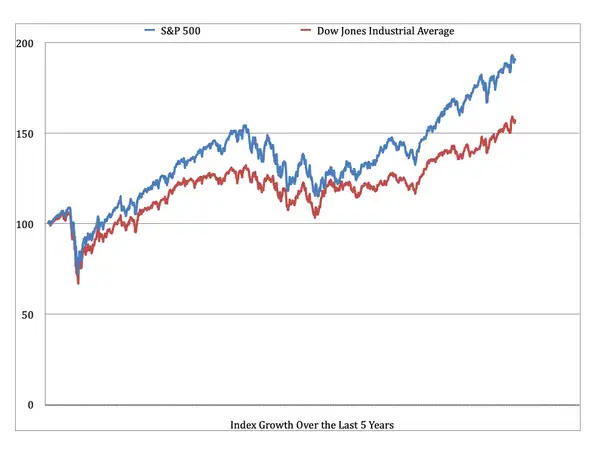
The chart, based on SP Global data, shows that the S&P 500 outperformed the Dow Jones Industrial Average over the past five years, with a steeper upward trajectory and stronger overall growth. While both indexes experienced similar dips during periods of economic disruption, such as the pandemic, the S&P 500 demonstrated greater resilience by recovering faster and reaching new highs.
This outperformance reflects the broader diversification of the S&P 500, which benefits from high-growth sectors like technology, compared to the Dow’s narrower focus on 30 established companies in traditional industries.
Key Takeaways: Dow Jones vs. S&P 500
- The S&P 500 offers a better reflection of the modern economy with higher growth potential over the past five years.
- The Dow Jones, while steady, lacks the momentum seen in the S&P 500, likely due to its narrower focus on fewer companies and traditional sectors.
S&P 500 vs. Nasdaq 100
The Nasdaq-100 is a stock market index made up of 100 of the largest non-financial companies listed on the Nasdaq exchange, with a strong emphasis on technology-focused businesses.
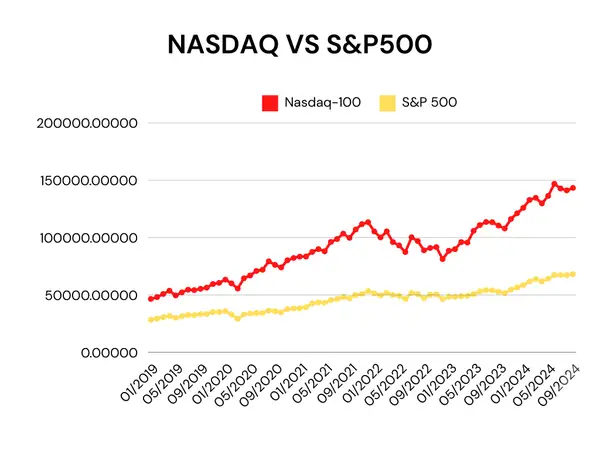
The Nasdaq-100 shows a significantly steeper growth trajectory, driven by its concentration in high-growth technology stocks, but also exhibits greater volatility with sharp peaks and troughs. In contrast, the S&P 500 displays a steadier, more gradual upward trend, reflecting its diversified composition across multiple sectors. The surge in the Nasdaq-100 around 2020-2021 clearly aligns with the digital transformation boom during the pandemic, while the S&P 500 grew more consistently, offering stability.
Key Takeaways:
- The Nasdaq-100 is ideal for investors seeking high growth and are comfortable with higher volatility.
- The S&P 500 offers a more balanced approach with steady, long-term returns and lower risk.
Ready?
Investing in the S&P 500 means tapping into the growth of the world’s most successful companies while building long-term wealth. Its historical performance, broad diversification, and steady returns make it an essential part of any smart investment strategy.
Morpher makes this journey effortless. With fractional trading, zero-commission investing, and blockchain transparency, you can start investing in the S&P 500 with confidence and ease. No hidden fees, no unnecessary barriers—just a simple, effective way to grow your wealth from anywhere in Europe.
Start your S&P 500 investing today—no big budget or middlemen needed.

Disclaimer: All investments involve risk, and the past performance of a security, industry, sector, market, financial product, trading strategy, or individual’s trading does not guarantee future results or returns. Investors are fully responsible for any investment decisions they make. Such decisions should be based solely on an evaluation of their financial circumstances, investment objectives, risk tolerance, and liquidity needs. This post does not constitute investment advice.

Painless trading for everyone
Hundreds of markets all in one place - Apple, Bitcoin, Gold, Watches, NFTs, Sneakers and so much more.

Painless trading for everyone
Hundreds of markets all in one place - Apple, Bitcoin, Gold, Watches, NFTs, Sneakers and so much more.








